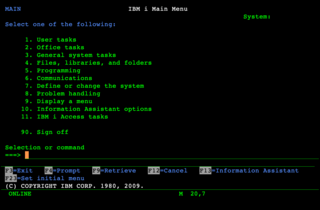Related Research Articles

In computing, a database is an organized collection of data stored and accessed electronically from a computer system. Where databases are more complex they are often developed using formal design and modeling techniques.
A relational database is a digital database based on the relational model of data, as proposed by E. F. Codd in 1970. A system used to maintain relational databases is a relational database management system (RDBMS). Many relational database systems have an option of using the SQL for querying and maintaining the database.
SQL is a domain-specific language used in programming and designed for managing data held in a relational database management system (RDBMS), or for stream processing in a relational data stream management system (RDSMS). It is particularly useful in handling structured data, i.e. data incorporating relations among entities and variables.

An object–relational database (ORD), or object–relational database management system (ORDBMS), is a database management system (DBMS) similar to a relational database, but with an object-oriented database model: objects, classes and inheritance are directly supported in database schemas and in the query language. In addition, just as with pure relational systems, it supports extension of the data model with custom data types and methods.

Hugh Darwen is a computer scientist who was an employee of IBM United Kingdom from 1967 to 2004, and has been involved in the development of the relational model.
Ingres Database is a proprietary SQL relational database management system intended to support large commercial and government applications.

Db2 is a family of data management products, including database servers, developed by IBM. They initially supported the relational model, but were extended to support object–relational features and non-relational structures like JSON and XML. The brand name was originally styled as DB/2, then DB2 until 2017 and finally changed to its present form.
First normal form (1NF) is a property of a relation in a relational database. A relation is in first normal form if and only if no attribute domain has relations as elements. Or more informally, that no table column can have tables as values. Database normalization is the process of representing a database in terms of relations in standard normal forms, where first normal is a minimal requirement. SQL does not support creating or using table-valued columns, which means most relational databases will be in first normal form by necessity. Database systems which do not require first normal form are often called no sql systems.
A hierarchical database model is a data model in which the data are organized into a tree-like structure. The data are stored as records which are connected to one another through links. A record is a collection of fields, with each field containing only one value. The type of a record defines which fields the record contains.

IBM i is an operating system developed by IBM for IBM Power Systems. It was originally released in 1988 as OS/400, as the sole operating system of the IBM AS/400 line of systems. It was renamed to i5/OS in 2004, before being renamed a second time to IBM i in 2008. It is an evolution of the System/38 CPF operating system, with compatibility layers for System/36 SSP and AIX applications. It inherits a number of distinctive features from the System/38 platform, including the Machine Interface, the implementation of object-based addressing on top of a single-level store, and the tight integration of a relational database into the operating system.

MonetDB is an open-source column-oriented relational database management system (RDBMS) originally developed at the Centrum Wiskunde & Informatica (CWI) in the Netherlands. It is designed to provide high performance on complex queries against large databases, such as combining tables with hundreds of columns and millions of rows. MonetDB has been applied in high-performance applications for online analytical processing, data mining, geographic information system (GIS), Resource Description Framework (RDF), text retrieval and sequence alignment processing.

Null or NULL is a special marker used in Structured Query Language to indicate that a data value does not exist in the database. Introduced by the creator of the relational database model, E. F. Codd, SQL Null serves to fulfil the requirement that all true relational database management systems (RDMS) support a representation of "missing information and inapplicable information". Codd also introduced the use of the lowercase Greek omega (ω) symbol to represent Null in database theory. In SQL, NULL is a reserved word used to identify this marker.
SQL/DS, released in 1981, was IBM's first commercial relational-database management system. It implemented the SQL database-query language.
Query optimization is a feature of many relational database management systems and other databases such as graph databases. The query optimizer attempts to determine the most efficient way to execute a given query by considering the possible query plans.
Raymond F. Boyce (1946–1974) was an American computer scientist who was known for his research in relational databases. He is best known for his work co-developing the SQL database language and Boyce-Codd normal form.
SQL:1999 was the fourth revision of the SQL database query language. It introduced many new features, many of which required clarifications in the subsequent SQL:2003. In the meanwhile SQL:1999 is deprecated.

Michael Ralph Stonebraker is a computer scientist specializing in database systems. Through a series of academic prototypes and commercial startups, Stonebraker's research and products are central to many relational databases. He is also the founder of many database companies, including Ingres Corporation, Illustra, Paradigm4, StreamBase Systems, Tamr, Vertica and VoltDB, and served as chief technical officer of Informix. For his contributions to database research, Stonebraker received the 2014 Turing Award, often described as "the Nobel Prize for computing."
A NoSQL database provides a mechanism for storage and retrieval of data that is modeled in means other than the tabular relations used in relational databases. Such databases have existed since the late 1960s, but the name "NoSQL" was only coined in the early 21st century, triggered by the needs of Web 2.0 companies. NoSQL databases are increasingly used in big data and real-time web applications. NoSQL systems are also sometimes called "Not only SQL" to emphasize that they may support SQL-like query languages or sit alongside SQL databases in polyglot-persistent architectures.
A relational data stream management system (RDSMS) is a distributed, in-memory data stream management system (DSMS) that is designed to use standards-compliant SQL queries to process unstructured and structured data streams in real-time. Unlike SQL queries executed in a traditional RDBMS, which return a result and exit, SQL queries executed in a RDSMS do not exit, generating results continuously as new data become available. Continuous SQL queries in a RDSMS use the SQL Window function to analyze, join and aggregate data streams over fixed or sliding windows. Windows can be specified as time-based or row-based.
Vera Watson was an American computer programmer, mountaineer and rock climber who made the first woman's solo climb of Acongagua, the highest mountain in the Americas. She also made several first ascents in the Kenai Mountains in Alaska. She was a member of the successful first all-women team to climb Annapurna, but was killed along with her partner Alison Chadwick-Onyszkiewicz while preparing to attempt the unclimbed central summit of the mountain.
References
- ↑ "A History and Evaluation of System R" (PDF). IBM.
"Phase Zero" of the project, which occurred during 1974 and-most of 1975, involved the development of the SQL user interface
- ↑ Selinger, PG; Astrahan, MM; Chamberlin, Donald D; Lorie, RA; Price, TG (1979), "Access Path Selection in a Relational Database Management System", Proceedings of the 1979 ACM SIGMOD International Conference on Management of Data, pp. 23–34, doi:10.1145/582095.582099, ISBN 978-0897910019
- ↑ McJones, P (1995), "SQL reunion", System R .